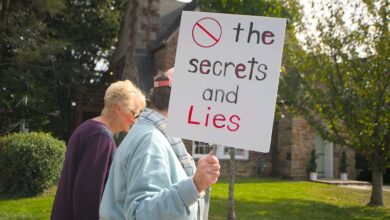The Echo Chamber Effect: When a False Claim Becomes “Fact”

Imagine you’re a high school math teacher, diligently preparing lessons, helping students grapple with algebra and geometry. You love your job, the energy of the classroom, and the small victories when a concept finally clicks for a struggling student. Then, one day, after a harmless Halloween celebration at school, your face, your name, and even your home address are suddenly plastered across the internet. You’re being accused of mocking a prominent political figure, and the floodgates open: hateful messages, doxxing, and terrifyingly, death threats. All because of a costume that had absolutely nothing to do with the person you’re accused of satirizing. Sound far-fetched? Sadly, this isn’t a dystopian novel; it’s a chilling reality for a group of educators right now.
This isn’t just about a few angry comments online. We’re talking about a targeted campaign of harassment and intimidation stemming from a single, demonstrably false claim. The incident highlights a deeply troubling trend: how easily misinformation can ignite a digital mob, how quickly it can escalate into real-world danger, and the immense vulnerability of our educators in an increasingly polarized society.
The Echo Chamber Effect: When a False Claim Becomes “Fact”
The story unfolded swiftly, as these digital wildfires often do. A Turning Point USA official, a prominent conservative youth organization, posted a picture of a group of high school math teachers dressed as the “Four Horsemen of the Apocalypse” for Halloween. The claim? That these costumes were an elaborate, politically charged jab at Charlie Kirk, the founder of Turning Point USA. The problem? The math department’s theme was chosen months in advance, completely unrelated to Kirk, and a common enough Halloween trope.
But facts, it seems, were an afterthought. The initial post, shared across social media platforms, quickly gained traction within an echo chamber primed to believe such accusations. Screenshots of the teachers, often with their faces circled, circulated widely, accompanied by inflammatory captions and calls to action. The sheer speed and volume of engagement were staggering, turning a simple, innocent costume choice into a national controversy overnight.
From Outrage to Intimidation: The Escalation of Digital Threats
What started as a misinformed critique rapidly morphed into something far more sinister. Online forums and social media threads filled with vitriol. These weren’t just disapproving comments; they were personal attacks, character assassinations, and chilling threats against the teachers’ lives. Anonymous users promised to track them down, wishing them harm, and even encouraging violence. The internet, in its darkest corners, transformed into a weapon, aimed directly at innocent individuals.
It’s easy to dismiss online threats as mere words, but for the recipients, they are terrifyingly real. Every notification, every unknown number, every strange car passing by becomes a source of anxiety. The safety of their home, their workplace, and even their daily commute is compromised. This isn’t just harassment; it’s psychological warfare, designed to instill fear and silence dissent, even when no dissent was initially intended.
Beyond the Screen: The Tangible Cost for Educators
This incident isn’t an isolated anomaly; it’s a stark reminder of the increasingly hostile environment faced by educators across the country. Teachers are already stretched thin, navigating budget cuts, overcrowded classrooms, and the emotional toll of their demanding profession. Now, they must also contend with the threat of being targeted by online mobs, their careers and personal safety jeopardized by a single, unchecked piece of misinformation.
Think about the profound impact on these teachers’ lives. Their focus shifts from lesson plans and student well-being to personal security and managing an onslaught of hate. Their ability to do their job effectively, to create a safe and nurturing learning environment, is severely compromised when they are constantly looking over their shoulder. Who would want to enter a profession where a simple Halloween costume could lead to death threats?
The Chilling Effect on School Culture
The ripple effects extend far beyond the individual teachers. An incident like this sends a chilling message to every educator in the school, and indeed, across the nation. It creates an atmosphere of fear and self-censorship. Teachers might think twice about their classroom decorations, their choice of reading materials, or even their personal opinions outside of school hours, fearing that any perceived misstep could invite similar retaliation.
This is a direct assault on academic freedom and the very essence of what a school should be: a place for open inquiry, intellectual exploration, and safety. When teachers are afraid to express themselves, or even to enjoy a simple holiday tradition, it erodes the trust and openness that are fundamental to effective education.
Reclaiming the Narrative: Protecting Our Schools and Our Sanity
So, what can we do when the digital landscape feels so wild and uncontrollable? The answer lies in a multi-pronged approach that demands both individual responsibility and collective action. First, and perhaps most crucially, is the need for critical media literacy. Before sharing any inflammatory content, especially claims that seem designed to provoke outrage, we must pause and ask: Is this true? Is there a credible source? What’s the context?
We need to cultivate a culture of verification, not just of immediate reaction. This isn’t about stifling free speech, but about promoting responsible speech. Social media platforms also bear a significant responsibility to address the rampant spread of misinformation and to protect individuals from targeted harassment and doxxing. Their algorithms, often designed to maximize engagement, can inadvertently amplify hate and falsehoods.
On a local level, communities must stand firmly behind their educators. School districts, parents, and community leaders have a vital role to play in publicly defending their staff against unfounded attacks, providing support, and ensuring their safety. Showing solidarity can make a profound difference, letting teachers know they are valued and not alone against the digital tide.
Ultimately, this incident is a sobering reminder that our online actions have very real, very painful consequences in the offline world. It’s a call to examine our own roles in the spread of information, to prioritize empathy over outrage, and to fiercely protect those who dedicate their lives to educating the next generation. Our teachers deserve better than to face death threats over a Halloween costume; they deserve our respect, our support, and a safe environment in which to shape young minds.





